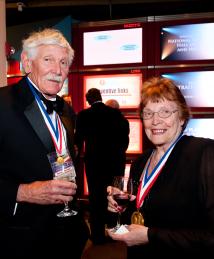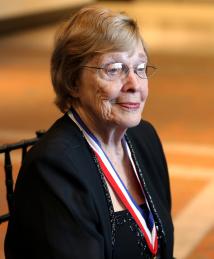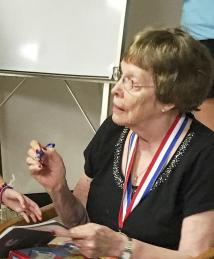Helen M. Free
"Our work with developing tests for diseases such as diabetes and our emphasis in promoting health and wellness has been challenging, exciting and rewarding. But most of all, we had fun"
Helen Murray Free was a pioneer in diagnostic chemistry. Her lifesaving research in medical and clinical urinary testing led to convenient dip-and-read urine tests including Clinistix®, which aids diabetes monitoring by detecting glucose.
Free was born in Pittsburgh in 1923, and her family moved to Ohio when she was 3. An excellent student, Free enrolled at the College of Wooster in 1941 and originally majored in English and Latin with the intention of pursuing a career in education.
Following the attack on Pearl Harbor, while many men were drafted into the military, the College of Wooster encouraged women to study science. Free chose to change her major to chemistry. Reflecting on this decision, she said, “I think that was the most terrific thing that ever happened because I certainly wouldn’t have done the things I’ve done in my lifetime.”
After Free earned her bachelor’s degree in chemistry in 1944, she was offered a position at Miles Laboratories, now Bayer Inc., in Elkhart, Indiana. She began working as a chemist in quality control, testing the quality of vitamin ingredients. She later moved to the biochemistry division, which was led by her future husband and fellow National Inventors Hall of Fame® Inductee Alfred Free. They married in 1947 and became lifelong partners in research, revolutionizing medical diagnostics with procedures that still are used in laboratories worldwide.
The Frees’ early work focused on improving Clinitest®, a tablet that tested glucose levels in urine. This was the first diagnostic test that could be done in a doctor’s office or a hospital without complex laboratory facilities, and it was even simple enough for patients to use at home.
The Frees also developed tests such as Acetest® for diabetic patients, and Icotest®, which was used to identify Hepatitis A. Icotest became the blueprint for an even more convenient diagnostic test using chemically treated paper strips – Clinistix. This test used a strip of paper containing reagents that produced color changes, indicating the presence of glucose in a urine sample. Introduced in 1956, Clinistix made it possible for millions of people to monitor their diabetes in a simple and convenient way. Today, the brand remains in use and is marketed by Siemens Healthcare Diagnostics.
Following the success of Clinistix, the Frees developed additional urine tests to accurately monitor pH levels, nitrates, ketones and bilirubin. By 1981, they had developed Multistix®, a single urine test that included 10 different clinical tests on one strip, enabling fast, easy analysis of health issues, from monitoring liver function and carbohydrate status to detecting urinary tract infection and kidney disorders.
In 1978, Free earned her master’s degree in clinical laboratory management from Central Michigan University. After retiring in 1982, she continued to work as a consultant at Miles for many years, and she served as the president of both the American Association for Clinical Chemistry and the American Chemical Society (ACS). Her many awards include the ACS Garvan Medal in 1980, and the National Medal of Technology and Innovation in 2009.
As she was inducted into the National Inventors Hall of Fame in 2000, Free said, “Our work with developing tests for diseases such as diabetes and our emphasis in promoting health and wellness has been challenging, exciting and rewarding. But most of all, we had fun.”
In recognition of her commitment to promoting science education, ACS created the Helen M. Free Award for Public Outreach in 1995. Her legacy also continues through the Al and Helen Free Foundation, which contributes to the National Inventors Hall of Fame Children’s Education Fund, providing opportunities for underserved children to attend nationwide, hands-on National Inventors Hall of Fame education programs.




